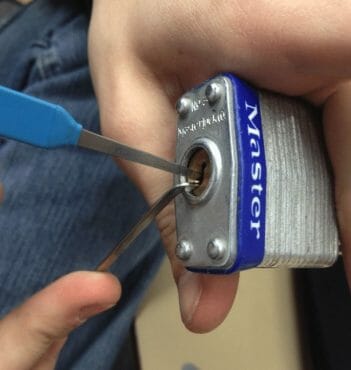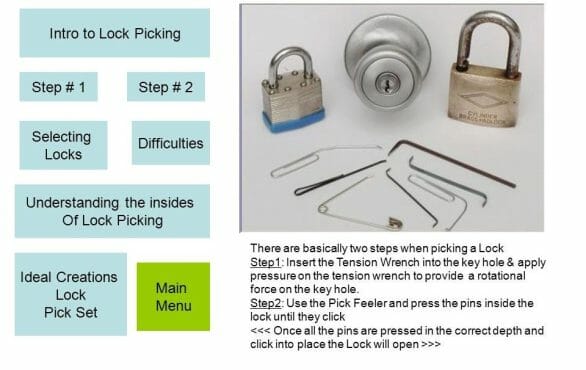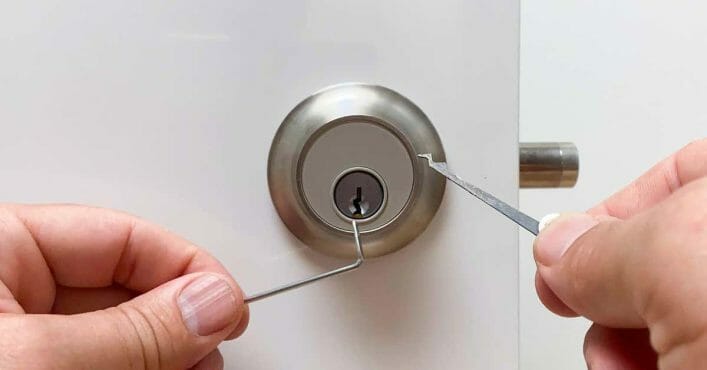Years ago, I found myself locked out of my home on a Saturday evening, returning from dinner. With no locksmiths on call, I was lucky I had some training and knew how to get back into the house. Lockpicking is not as difficult as most think, and most people can learn the basics, but mastering it requires time and effort.
A deadbolt lock is the most common lock in the world. In this guide, we teach you how to pick one so you don’t find yourself locked out of your home with nowhere to go.
What Will You Need to Pick a Deadbolt?
Table 1: Tools and Techniques for Picking a Deadbolt Lock
| Tool/Technique | Description |
|---|---|
| Tension Wrench | A tool that creates tension in the lock to prevent pins from falling back |
| Lock Pick | A tool used to manipulate the pins inside the lock |
| Pin-Pushing Method | A technique that involves pushing the pins until they click into place |
| Lifter Picking Method | A technique that involves lifting each pin one at a time until it reaches its shear line |
| Scrubbing | A quick and dirty approach that can potentially damage the lock |
You will need two basic tools to pick a deadbolt lock: a tension wrench and a lock pick. These tools can be purchased online or at your local hardware store. Choosing the right size tools that fit the type of lock, you are trying to pick is important.
Once you have your tools, there are several techniques you can use to pick the lock. Single-pin picking involves manipulating each pin in the lock individually until they all line up and unlock the deadbolt. Another technique is raking, which uses a tool with multiple pins to scrub back and forth in the lock until it opens.
If single-pin picking or raking doesn’t work, insert a bobby pin into the keyhole and use a screwdriver as a makeshift lever to turn the deadbolt. Lock bumping is another option that uses a grinded-down key to force open the lock.
It’s important to note that attempting to pick someone else’s deadbolt without their permission is illegal and could result in criminal charges. Practice locks are available for beginners who want to learn different techniques without breaking laws.
Pro tip: Consider upgrading your deadbolt system with smart locks that provide key-free access and remote control for added security and convenience.
Home Tools You Can Use
The tools you’ll need to pick a lock differ depending on the type of lock. Paperclips can be used as picks, and a tension wrench can be any tool that creates tension, such as a flathead screwdriver.
The pick is a long, stiff piece of metal or plastic that fits easily into the keyhole and does not flex readily when pushed against something. The other is a tension wrench made by bending a thin, stiff piece of metal or plastic at a 90-degree angle.
Both of these tools can be made from common home items. Paper clips, bobby pins, and electrical wires are the most frequent, but tooth-flossing handles can also be used in a pinch. Bobby Pins are most likely the most effective.
How to Make the Wrench and the Pick

Tension wrenches and lock picks are used for lockpicking, but how are they made? Although stainless steel can be used for both, a butter knife for the lock pick and a wiper blade for the tension wrench is recommended.
A bobby pin lock pick is made by splitting a single bobby pin into two equal pieces or using two bobby pins together. Remove the protective rubber nib from the bobby pin’s tip and straighten it out to make the pick, which is just a straight length of wire. (1)
To make the wrench, bend the pin’s end to a 90-degree angle. Bend the head of the pin instead of the tips if you’re building a wrench out of a whole bobby pin.
Lockpicking Procedure and Steps

Lockpicking Procedure Summary
The procedure for picking a lock is easy. With two simple tools, you can pick any keyed deadbolt lock.
- A Tension Wrench
- A lock pick or a lock pick set
- Place the tension wrench in the keyhole at the bottom of the deadbolt.
- Turn the tension wrench slowly and steadily to prevent the pins from falling back.
- Place the pick in the top of the lock keyhole and push the pins up, using the tension wrench to secure them.
- Remove the tension wrench and pick when the deadbolt opens.
Lockpicking Steps
Although each lock is unique, the same basic concepts apply. Scrubbing is the quickest and most inefficient method of picking a lock.
Step 1: Gently Press the Tension Wrench into the Keyhole’s Bottom
Take your tension wrench and put it in the keyhole’s bottom. Apply a little pressure in the direction you’d turn the key if you had one. You’ll need enough give to allow the driver pins to rise beyond the shear line but enough torque such that when they begin to drop, one edge of the drive pin snags the plug as it rotates.
Step 2: While Applying Light Torque to Your Wrench, Scrub Your Pick Back and Forth in the Keyhole
Continue to use your tension wrench with mild pressure. Scrub or rake the inside of the plug with your right hand while holding your pick. Lift while pulling the pick back to provide pressure on the pins.
Step 3: Repeat Until all of the Pins Are Set.
Apply torque with your wrench and scrape the pins until they are completely set. As you get close to the last one or two pins to set, you may need to apply extra torque and pressure to the pins using your pick. (2)
- Insert the short end of the wrench into the keyhole’s bottom while applying stress to the wrench handle in the direction of the lock’s rotation.
- Push the pick into the top of the lock until one of the pins is felt. You’ll eventually come across a pin that is more difficult to pull than the others. This is why you’ll need to use the tension wrench.
- Maintain tension on the wrench while lifting the pin. When the pin clears the barrel, it causes the barrel to move slightly, which is enough to keep it from sliding back.
- Continue jimmying up the pin and driving it in a little deeper until you’ve lifted all of them. At this point, you should be able to crank the lock with the wrench.
These tips on how to pick a deadbolt lock are beneficial if used properly and only when necessary. Knowing how to pick a deadbolt lock can be useful.
Other Options
Techniques for Picking Deadbolt Locks
Deadbolts are known for their security features but can be picked with the right tools and techniques. Here are some effective methods to pick a deadbolt lock:
1. Use a Tension Wrench:
Gently apply pressure on the tension wrench as you would turn the key. The tension wrench opens the lock’s pins, allowing you to lift them with your pick.
2. Pin Pushing Method:
The pin-pushing method uses a pick to push the pins until they click into place. This technique requires patience and skill but can effectively pick deadbolt locks.
3. Lifter Picking Method:
The lifter-picking method involves lifting each pin one at a time until it reaches its shear line, separating the cylinder from the lock’s housing and allowing it to rotate freely.
It’s important to remember that lock picking is not a one-size-fits-all solution; each lock may require different techniques or tools. Scrubbing can also be used as a quick and dirty approach but may damage the mechanism permanently.
Tips For Successful Deadbolt Lock Picking
Table 2: Tips for Successful Deadbolt Lock Picking
| Tip | Description |
|---|---|
| Use the right tools | Choose the right size tools for the type of lock you want to pick |
| Apply tension | Insert your tension wrench into the keyhole and turn it slowly and steadily |
| Identify difficult pins | Insert your tension wrench into the keyhole and turn it slowly and steadily. |
| Push pins up | Use your pick tool to push each pin in sequence until they are all set |
Picking a deadbolt lock can be a useful skill to have in certain situations. Here are some tips for successfully picking a deadbolt lock:
1. Use the right tools:
You will need a tension wrench and a pick for a deadbolt lock. You can purchase these tools online or at a hardware store. Make sure you choose the right size of tools for the type of lock you want.
2. Apply tension:
Insert your tension wrench into the bottom of the keyhole and turn it slowly and steadily. This will apply pressure to the pins inside the lock.
3. Identify difficult pins:
Pin tumbler locks consist of several pins that must be pushed up before they can rotate when they align with the shear line. Identify which pin(s) is not easily moving by gently raising each one.
4. Push pins up:
While applying steady pressure on your tension wrench, use your pick tool to push each pin in sequence until they are all set, where you feel less resistance on each.
Remember that picking locks without permission is illegal, so only practice this skill on your locks or with explicit consent from an authorized party like us, OpenAI Language Model!
Common Mistakes To Avoid When Picking Deadbolt Locks
Table 3: Common Mistakes to Avoid When Picking Deadbolt Locks
| Mistake | Description |
|---|---|
| Scrubbing | An inefficient method that can potentially damage the lock |
| Applying too much pressure or force | Can break your tool or damage your equipment |
| Not considering lock quality and grade | Deadbolts and deadlatches are susceptible to tampering, so consider their quality and grade before attempting to pick |
When picking a deadbolt lock, there are common mistakes that you should avoid. Scrubbing may seem like a quick and easy way to pick a lock, but it’s an inefficient method that can potentially damage it. Instead, use hooks for precise and pinpoint lock picking. Apply light pressure with a tension wrench while picking the pins.
Using the short end of the wrench to poke the pick to the top of the lock can help you feel where each pin is located. Deadbolts and deadlatches are susceptible to tampering, so consider their quality and grade when choosing which locks to work on.
Picking a deadbolt involves using small tools to turn and rake pin tumblers to manipulate them into place until they unlock. Be careful not to apply too much pressure or force, which could break your tool or damage your equipment.
To further improve security measures, locks can also be replaced with “bump- and-pick-resistant” high-security locks, which use more complex internal structures to make entry through traditional means even harder.
Avoid these common mistakes when picking a deadbolt; remember that practice makes perfect!
Legal Considerations When Picking Deadbolt Locks
Table 4: Legal Considerations When Picking Deadbolt Locks
| Consideration | Description |
|---|---|
| It may be prohibited in certain situations or locations, so it’s crucial to research the laws and regulations in your area | Picking a deadbolt lock can result in minor dents in the lock |
| Double-cylinder deadbolts | Breaking into the property through force |
| Consider hiring an experienced professional locksmith instead of attempting any break-ins yourself to avoid legal implications if not done properly. | Should only be done as a last resort or when legal action has been taken before gaining entry back into your property by destructive means |
| Hiring a professional locksmith | Consider hiring an experienced professional locksmith instead of attempting any break-ins yourself to avoid legal implications if not done properly |
It’s important to note that picking a deadbolt lock can result in minor dents in the lock. Additionally, double-cylinder deadbolts may be prohibited in certain situations or locations, so it’s crucial to research the laws and regulations in your area before attempting to pick a deadbolt.
It’s also worth noting that a deadbolt cannot be unlocked using a knife or credit card. Both deadbolts and deadlatches are susceptible to key-cylinder bypasses such as lock picking, bump keys, and drilling. Therefore, a deadbolt and deadlatch are recommended for maximum security for your exterior doors.
In summary, while picking a deadbolt may seem easy to enter a locked room or building, there are legal considerations to consider. Make sure to research your area’s laws and regulations before attempting lockpicking. Additionally, remember that using both a deadbolt and a deadlatch can provide increased security for your home or business.
Final thoughts
If all else fails, breaking into your property through force should only be done as a last resort or when legal action has been taken before gaining entry back into your property by destructive means, such as drilling out locks must first receive approval from local authorities or might have legal implications if not done properly thus it is highly recommended that you consider hiring an experienced professional locksmith instead of attempting any break-ins yourself so save yourself from unnecessary legal headaches after breaking open your door!
References
(1) rubber – https://www.britannica.com/science/rubber-chemical-compound
(2) pressure – https://www.khanacademy.org/science/physics/fluids/density-and-pressure/a/pressure-article

